Industrial Production Operation in September 2020
In September, the value added of industries above designated size increased by 6.9 percent year-on-year (the growth rate of the value added below is the real growth rate after deducting the price factor), and the growth rate was 1.3 percentage points higher than that in August. On a month on month basis, in September, the value added of industries above designated size increased by 1.18 percent over the previous month. In the first nine months, the value added of industries above designated size increased by 1.2 percent year on year.
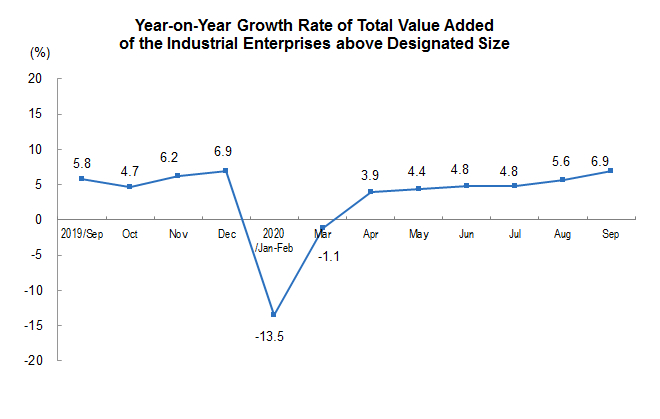
In terms of three categories, in September, the value added of the mining industry increased by 2.2 percent year-on-year, up 0.6 percentage point over last month; that of the manufacturing industry increased by 7.6 percent, 1.6 percentage points of increase over last month; that of the production and distribution of electricity, heating, gas and water increased by 4.5 percent, 1.3 percentage points of lower over last month.
In terms of economic types, in September, the value added of state-owned holding enterprises increased by 6.5 percent year-on-year; that of joint-stock enterprises increased by 6.8 percent; that of foreign, Hong Kong, Macao and Taiwan invested enterprises increased by 7.1 percent; and that of private enterprises increased by 7.9 percent.
In terms of different industries, in September, the value added of 35 of the 41 major industries maintained a year-on-year growth. The value added of agricultural and sideline food processing industry increased by 2.7 percent, that of textile industry rose by 5.6 percent, that of chemical raw materials and chemical products manufacturing industry increased by 7.5 percent, that of non-metallic mineral products industry increased by 9.0 percent, that of ferrous metal smelting and processing industry and non-ferrous metal smelting and processing industry rose by 9.0 and 3.5 percent, that of general equipment manufacturing industry, special equipment manufacturing industry and automobile manufacturing industry rose by 12.5, 8.0 and 16.4 percent, that of railways, shipbuilding, aerospace and other transportation equipment increased by 3.9 percent, that of electrical machinery and equipment manufacturing, and manufacturing of computer, communication and other electronic equipment increased by 15.9 and 8.0 percent, and that of the production and distribution of electric power, heat and water increased by 4.2 percent.
In terms of different regions, in September, the value added of the eastern region, central region, western region and northeast region increased by 8.0, 6.5, 4.7 and 8.5 percent.
In terms of different products, in September, 426 of 612 products increased year on year. Steel was 118.06 million tons, increased by 12.3 percent; cement was 233.41 million tons, increased by 6.4 percent; ten non-ferrous metals was 5.32 million tons, increased by 7.3 percent year on year; ethylene was 1.87 million tons, increased by 12.6 percent; automobile was 2,461 thousand sets, increased by 13.8 percent, including 136 thousand new energy vehicles, increased by 51.1 percent; power generation was 631.5 billion kilowatt hours, increased by 5.3 percent; crude oil processing capacity was 57.35 million tons, up by 1.3 percent.
In September, the product sales rate of industrial enterprises was 98.6 percent, decreased by 0.4 percentage point over the same month of last year; the export delivery value of industrial enterprises was 1,137.6 billion yuan, down by 1.8 percent on a year-on-year basis in nominal terms.
| Industrial Production Operation in September 2020
| ||||
| Indicators | September | Jan-Sep | ||
| Absolute Value | Increase rate Y/Y (%) | Absolute Value | Increase rate Y/Y (%) | |
| Value-added of Industry Above Designated Size | … | 6.9 | … | 1.2 |
| Grouped by Three Sectors |
|
|
|
|
| Mining and Quarrying | … | 2.2 | … | -0.6 |
| Manufacturing | … | 7.6 | … | 1.7 |
| Manufacture of high-tech industry | … | 7.8 | … | 5.9 |
| Production and Distribution of Electricity, Heating Power, Gas and Water | … | 4.5 | … | 0.8 |
| Grouped by Status of Registration |
|
|
|
|
| State-holding Enterprises | … | 6.5 | … | 0.9 |
| Joint-Stock Enterprises | … | 6.8 | … | 1.5 |
| Enterprises with Funds from Hong Kong, Macao and Taiwan, and Foreign Funded Enterprises | … | 7.1 | … | 0.3 |
| Private Enterprises | … | 7.9 | … | 2.1 |
| The Value-Added of the Main Industrial Sectors |
|
|
|
|
| Processing of Food from Agricultural Products | … | 2.7 | … | -3.4 |
| Manufacture of Foods | … | 6.5 | … | 0.8 |
| Manufacture of Textile | … | 5.6 | … | -1.7 |
| Manufacture of Chemical Raw Material and Chemical Products | … | 7.5 | … | 1.5 |
| Manufacture of Medicines | … | 7.4 | … | 3.0 |
| Manufacture of Rubber and Plastics Products | … | 8.4 | … | -0.7 |
| Manufacture of Nonmetal Mineral Products | … | 9.0 | … | 0.8 |
| Manufacture of Ferrous Metal Smelting and Pressing | … | 9.0 | … | 5.3 |
| Manufacture and Processing of Non-Ferrous Metals | … | 3.5 | … | 1.9 |
| Manufacture of Fabricated Metal Products | … | 12.6 | … | 1.8 |
| Manufacture of General Machinery | … | 12.5 | … | 2.6 |
| Manufacture of Special-Purpose Machinery | … | 8.0 | … | 5.1 |
| Manufacture of Motor Vehicles | … | 16.4 | … | 4.4 |
| Manufacture of Railways, Shipbuilding, Aerospace and Other Transportation Equipment | … | 3.9 | … | -2.1 |
| Manufacture of Electric Machinery and Equipment | … | 15.9 | … | 5.6 |
| Manufacture of Computer, Communication Equipment and Other Electronic Equipment | … | 8.0 | … | 7.2 |
| Production and Supply of Electric Power and Heat Power | … | 4.2 | … | 1.0 |
| Output of Major Products |
|
|
|
|
| Cloth (100 million meters) | 34 | -12.6 | 262 | -21.6 |
| Sulfuric Acid(100%) (10,000 tons) | 709 | -3.5 | 6074 | -3.0 |
| Caustic Soda(100%) (10,000 tons) | 312 | 9.9 | 2633 | 2.2 |
| Ethylene (10,000 tons) | 187 | 12.6 | 1547 | 1.6 |
| Chemical Fiber (10,000 tons) | 542 | 2.5 | 4439 | 0.3 |
| Cement (10,000 tons) | 23341 | 6.4 | 167627 | -1.1 |
| Plate Glass (10 000 weight boxes) | 8123 | 1.6 | 69952 | 0.4 |
| Pig Iron (10,000 tons) | 7578 | 6.9 | 66548 | 3.8 |
| Crude Steel (10,000 tons) | 9256 | 10.9 | 78159 | 4.5 |
| Steel Products (10,000 tons) | 11806 | 12.3 | 96424 | 5.6 |
| 10 Kinds Of Nonferrous Metals (10,000 tons) | 532 | 7.3 | 4518 | 3.5 |
| Of which: Primary Aluminium (Electrolytic Aluminium) (10,000 tons) | 316 | 7.9 | 2745 | 2.8 |
| Metal-Cutting Machine Tool (10,000 sets) | 4 | 20.6 | 32 | -2.7 |
| Industrial Robot (unit/set) | 23194 | 51.4 | 160715 | 18.2 |
| Automobile (10,000 sets) | 246.1 | 13.8 | 1650.5 | -6.1 |
| Of which: Saloon cars (10,000 sets) | 92.5 | 3.0 | 621.7 | -15.0 |
| SUV(10,000 sets) | 89.3 | 22.0 | 563.3 | -1.9 |
| Of which: New Energy Automobile (10,000 sets) | 13.6 | 51.1 | 77.8 | -11.4 |
| Generator Set (Power Generating Equipment) (10,000 kWh) | 1290 | 24.6 | 9283 | 21.0 |
| Micro Computer Equipment (10,000 sets) | 3788 | 5.1 | 25600 | 5.6 |
| Mobile Phone (10,000 sets) | 14878 | 0.4 | 101511 | -5.1 |
| Of which: Smartphone (10,000 sets) | 10491 | 3.4 | 75750 | 3.4 |
| Integrated Circuit (100 ,000,000 pcs) | 241 | 16.4 | 1822 | 14.7 |
| Raw Coal (10,000 tons) | 33107 | -0.9 | 278715 | -0.1 |
| Coke (10,000 tons) | 4059 | 2.6 | 35086 | -0.9 |
| Crude Oil (10,000 tons) | 1610 | 2.4 | 14625 | 1.7 |
| Crude Processing Volume (10,000 tons) | 5735 | 1.3 | 49538 | 2.9 |
| Natural Gas (100 million Cubic Meters) | 146 | 7.6 | 1371 | 8.7 |
| Electricity (100 million kWh) | 6315 | 5.3 | 54086 | 0.9 |
| Thermal Power | 4223 | 0.2 | 38316 | -0.3 |
| Hydro-electric Power | 1385 | 22.8 | 9025 | 0.9 |
| Nuclear Power | 319 | 7.4 | 2700 | 6.4 |
| Wind Power | 267 | 11.3 | 2972 | 10.0 |
| Solar Power | 121 | 4.0 | 1071 | 7.2 |
| Sales Ratio (%) | 98.6 | -0.4(percentage point | 97.7 | -0.4(percentage point |
| Export Delivery Value (100 million yuan) | 11376 | -1.8 | 86552 | -3.1 |

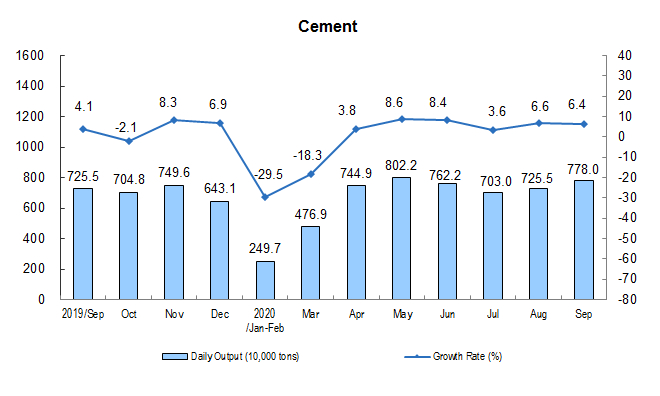
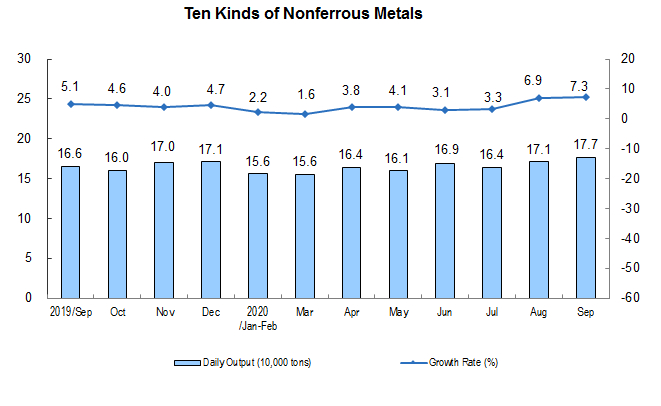
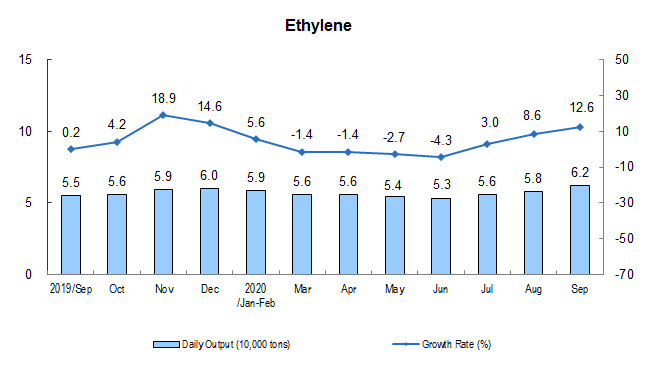
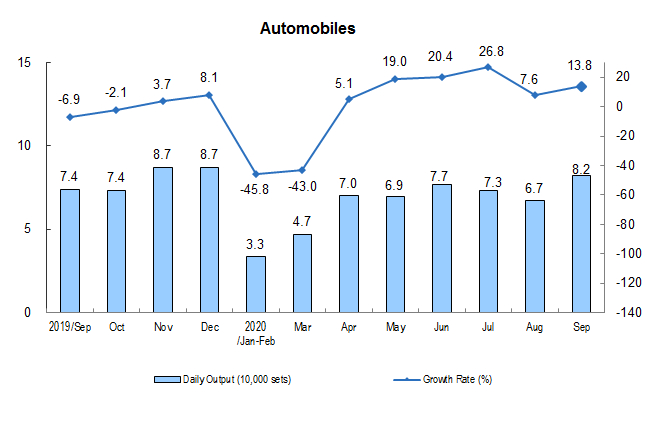
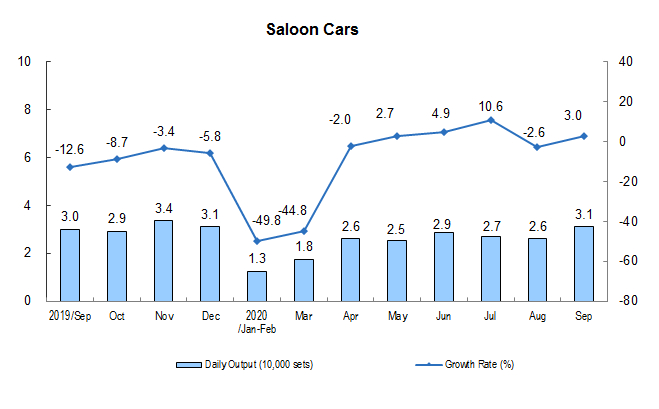
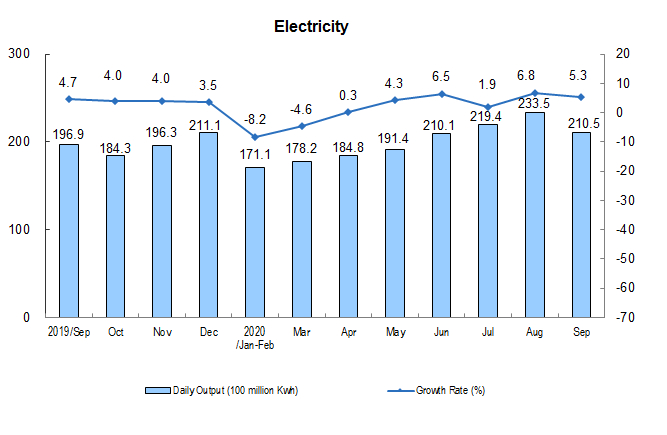

Annotations:
1. Explanation of Indicator.
Growth rate of value added of the industrial enterprises: also known as industrial growth rate, which is used to reflect a certain period of increase or decrease in volume of industrial production indicators of the degree of change. The indicator can be used to estimate the short-term trend of the industrial economy, to judge the extent of the economic boom, and also to be an important reference and basis for the formulation and adjustment of economic policies, and for the implementation of macroeconomic adjustment and control.
Sales ratio: refers to sale value and industrial output value, which reflecting the situation between production and sales of industrial products.
Export delivery value: refers to the foreign trade department of industrial enterprises or self-run (commission) exports (including sold in Hong Kong, Macao and Taiwan), with the price of foreign exchange settlement of product value, and foreign samples, materials processing, component assembly and compensation trade product value.
Daily product output: the total production of the total value added of the industrial enterprises above designated size in the current month divided by number of days in the month.
2. Statistical Coverage.
The standard starting point of industrial enterprises above designated size was 20 million yuan of annual revenue from primary business.
Due to the annual changes of the coverage of industrial enterprises above designated size, and in order to ensure that the data for this year is comparable with that of the previous year, the data of the corresponding period used for calculating the year-on-year growth rates of various indicators such as product output is as consistent with the enterprise statistical coverage of the current period as possible, and there is a difference in caliber from the data published last year. The main reasons are: (1) Coverage changes of statistical units. Each year, some companies will be included in the survey after having reached requisite size, and some will exit the survey due to their smaller size, and there are also influence of new built and starting enterprises, bankruptcies, and companies that have been suspended or sold. (2) There is cross-regional repeated calculation in the output data of some enterprise group (company) products, which has been eliminated according to specific surveys.
3. Survey Methods.
The reports of industrial enterprises above designated size are conducted with complete survey on a monthly basis (Not report for January).
4. Division on Eastern, Central and Western Regions.
Eastern region includes Beijing, Tianjin, Hebei, Liaoning, Shanghai, Jiangsu, Zhejiang, Fujian, Shandong, Guangdong, and Hainan. Central region includes Shanxi, Jilin, Heilongjiang, Anhui, Jiangxi, Henan, Hubei, and Hunan. Western region includes Inner Mongolia, Guangxi, Chongqing, Sichuan, Guizhou, Yunnan, Tibet, Shaanxi, Gansu, Qinghai, Ningxia, and Xinjiang. Northeastern region includes Liaoning, Jilin and Heilongjiang.
5. Standard on industrial classification
NBS enforces New Standard on Industrial Classification for National Economic Activities" (GB/T 4754-2017). For details, please refer the following link: http://www.stats.gov.cn/tjsj/tjbz/hyflbz.
6. Revision on month-on-month data
The month-on-month growth rate of the total value added of the industrial enterprises above designated size from September 2019 to August 2020 was revised according to the results of automatic revision of seasonal adjustment model. The results are as follows:
| The Month-on-Month Growth Rate of Industrial Production Operation
| |
| Months | Growth Rate (%) |
|
|
|
| 2019-September | 0.80 |
| October | 0.39 |
| November | 0.83 |
| December | 0.61 |
| 2020-January | -2.28 |
| February | -23.97 |
| March | 30.72 |
| April | 1.95 |
| May | 1.33 |
| June | 1.31 |
| July | 0.98 |
| August | 1.03 |
| September | 1.18 |
|
|
|
